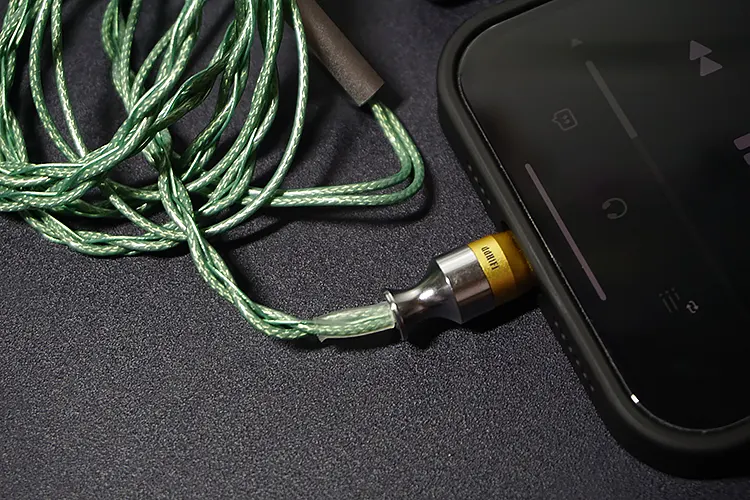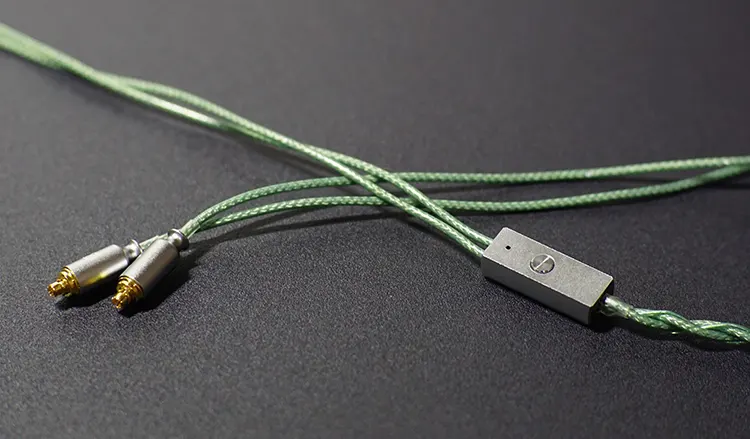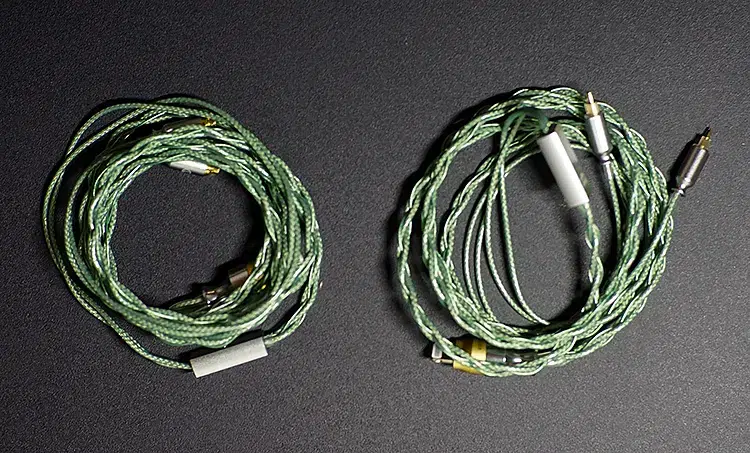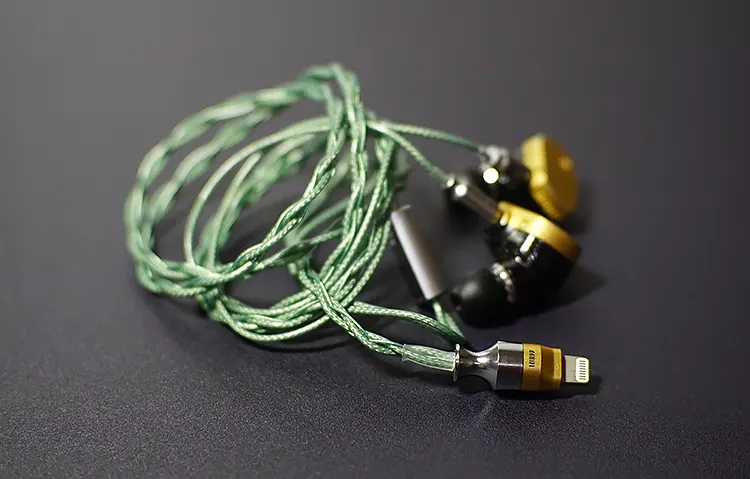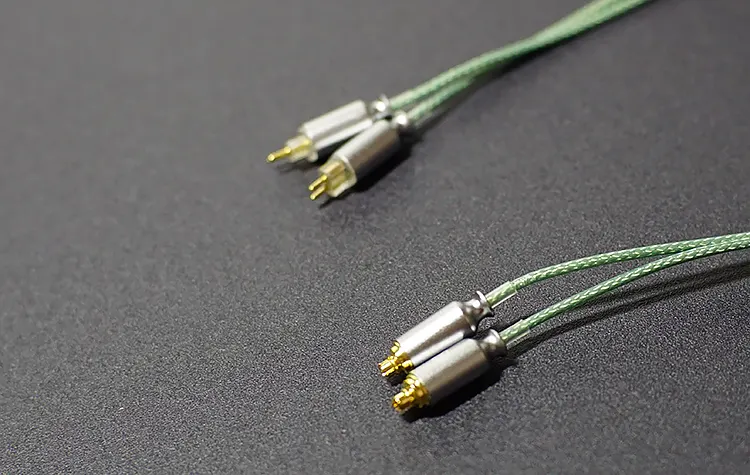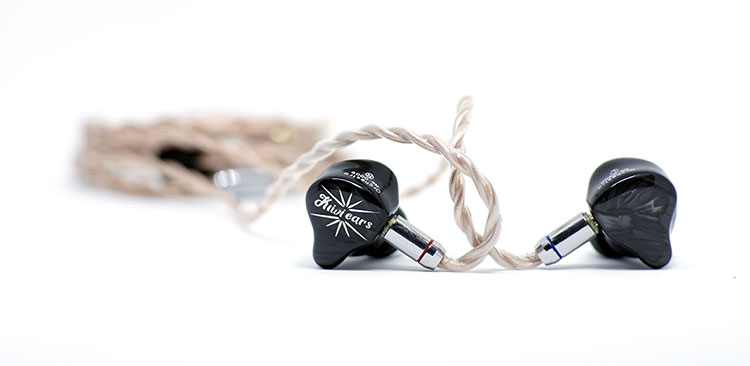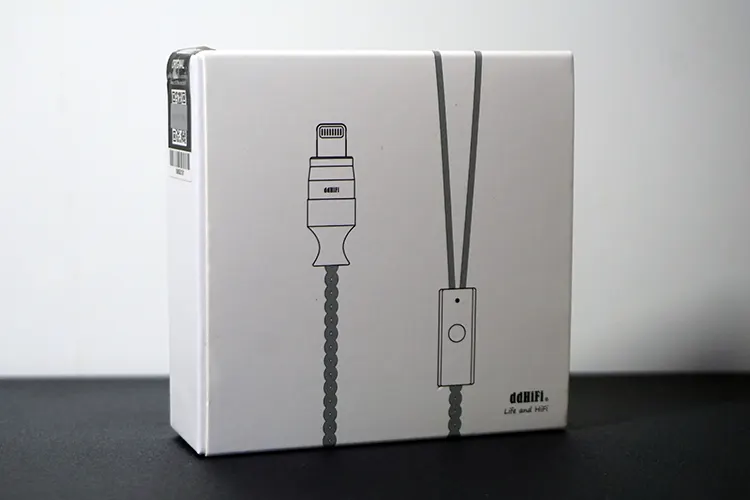This is an independent review of the ddHiFi M120B Lightning Edition which is an integrated C100 24BIT/48kHz DAC and IEM cable for iOS devices. It is priced at $89.99 SRP.
Disclaimer: This is a sample that was sent to us in exchange for our honest opinion. Headfonics is an independent website with no affiliate links. Many thanks to ddHiFi for their support
You can read about previous ddHiFi products we have previously featured on Headfonics here.
Note, that this article follows our latest scoring guidelines which you can read up on here.
ddHiFi is a trusted brand that produces exceptionally looking and performing cables and adapters that have been popular for the past 6 years in the audiophile world. I own a couple of these, the TC35i, TC35C, and TC44A to name a few, just chucked them inside my bag as I find them extremely useful day to day.
What I have now is another utility item, an upgrade cable that has a Lightning termination, perfect for when I’m on my iPhone.
The ddHiFi M120B is a new offering from ddHiFi that takes into consideration the pain points of casual listeners and audiophiles alike with the obsoletion of the 3.5mm headphone jack.
Priced at $89.99, it is to compete with the entry-level dongle DACs for mobile phones. With its integrated design and mic capabilities, will it have the edge over its competitors?
Tech Highlights & Design
Wire
The M120B, regarded as the “mini ocean” uses a shielded upgrade cable like the ddHiFi BC125A air ocean. Its main core is made of a high-purity OCC with a small amount of pure silver inside. Inside is a 25.6 AWG Litz high purity OCC and pure silver for the core and 22AWG Litz silver plated OFC for the shielding.
Aesthetics
The cable has a green-colored outer sheathing, which is surprisingly appealing. It is paired with the ddHiFi hardware with both gold and silver accents. The gold accent is more on the yellow side – similar to Campfire Audio Solaris’ gold color.
In-line DAC
The M120B deviates from the traditional mobile DAC setup with a DAC + cable setup, but instead fuses it into an all-in-one package, with a bonus in-line control and microphone support.
The placing is clever, instead of a plain traditional Y-splitter, a circuit board is placed to better distribute the weight. This ingenious design makes the product functional, with similar comfort to traditional cables.
ddHiFi also claims that the chip on board has efficient power decoding, which means lower power is used with the cable, preserving the oh-so-precious battery life of mobile phones.
Connection Options & Decoding
There are 4 options for this cable, made to cater to all music enthusiasts. You can choose between USB-C or lightning for the termination plug and MMCX or 0.78mm for the IEM plug.
For the termination plug, there is a key difference between the two, the DAC chip onboard is different.
For the USB-C termination, it uses an ALC5686 which can support PCM decoding of up to 32bit/384kHz. The lightning termination on the other hand has a C100 DAC chip with PCM decoding capability of up to 24bit/48kHz.
Aside from the plug terminations, the IEM side also has 2 choices – an MMCX and a 2-pin 0.78mm. This gives perfect flexibility for people who have already their own set of favorite IEMs and are looking for a plug-and-play solution when they’re on the go.
Handling
The ddHiFi M120B is a flexible cable that is comfortable to use. These are not flimsy but hold enough weight to be comfortable and functional at the same time.
Unfortunately, there are no ear-hooks or wire guides on the IEM connection, but they do hold in place even when walking leisurely. No microphonics were also observed, which was pleasantly surprising.
Controls
The splitter has a mini circuit board inside, which gives in-line controls and mic capabilities. It has 1 button which essentially functions like the traditional earphones with a mic module. Pressing once would pause, pressing twice would play the next track, and pressing thrice would play the previous track.
Packaging & Accessories
The ddHiFi M120B has straightforward packaging – a minimal box with the cable inside. Inside the box is the cable with protective packaging to protect the cable from freight.
Sound Impressions
All sound impressions were completed using a mixture of IEMs including the Campfire Solaris, Studio Ears Volume, and Kiwi Ears Orchestra. The source used is an iPhone 12 Pro Max.
Summary
For an entry-level DAC cable, this is a huge upgrade compared to the commonly available entry-level 3.5mm upgrade cables. Overall, it has a low noise floor, making sound across frequencies to have good clarity.
Timbre
The M120B enhances the upper and lower frequencies by adding more quantity and quality to it. Sub-bass and mid-bass are further enhanced and more evident when testing with IEMs with a flat tuning.
The upper midrange and treble regions are also highlighted, with a more forward retrieval. Although, it does feel a bit shriller and more technical with more detail retrieval.
The overall performance of the M120B cable is surprisingly good. There is little coloration, with no hint of warmth, but with more emphasis on the richness of detail retrieval.
Staging & Dynamics
The M120B does not expand the staging width or height of the IEMs. Depending on the IEM, it does improve some aspects of the IEM.
It does increase the lower frequency, giving it a fuller body with more details and texture retrieved. The detail retrieval also gives it a better layering and separation. Overall, the improvements depend on personal taste and synergy with the IEM itself.
Synergy
The ddHiFi M120B has a decent level of synergy and pairings with IEMs, as it’s positioned to be used on the go.
The ddHiFi M120B is best paired with monitors that are flat or have a mid-centric response. The M120B highlights the highs and lows, which at times clash with certain IEMs. For example, with the Softears Volume, the treble is too aggressive for my taste, which should be avoided in pairing.
However, both the Kiwi Orchestra and Campfire Solaris do well in boosting the highs and lows of both IEMs.
Select Comparisons
Campfire Cable + Apple Lightning adapter
Technical
The Apple lightning dongle uses a similar chip to the ddHiFi M120B lightning, with the Apple dongle using a C101 DAC and the M120B using a C100 DAC. The two DAC chips are identical in looks, but there is very little information on how the 2 differ.
Campfire Audio Solaris’ stock cable is made of a Super Litz wire which is a multi-sized stranded SPC Litz wire jacketed in a nice supple twisted PVC jacket. The ddHiFi M120B is a Lutz high purity OCC and pure silver for the core and a Litz silver plated OFC shielding with a green-colored outer sheathing.
Design
The ddHiFi M120B has a slimmer form factor than the stock cable since it doesn’t need an adapter. This gives the M120B a big advantage, especially when moving around. Dongles are a nuisance that often is the point of failure in a compact setup.
Externally, the stock cable pairs have a silver and gold aesthetic. The ddHiFi M120B looks good as well, despite having a green sheath, and the gold accent having the same hue as the Solaris.
Performance
There was not much difference in terms of the sound signature. Given that the Solaris stock cable is significantly more expensive than the M120B, I was not expecting it to compete. However, the ddHiFi did make a dent with its impressive clarity and comparable performance.
However, the M120B still falls short with a rather narrower soundstage. The Campfire cable does better with its better dynamics and exceptional width, which means more spacing and layering between instruments and vocals.
Kiwi Ears Orchestra Cable + Apple Lightning dongle
Technical
The Apple lightning dongle uses a similar chip to the ddHiFi M120B lightning, with the Apple dongle using a C101 DAC and the M120B using a C100 DAC. The two DAC chips are identical in looks, but there is very little information on how the 2 differ.
Kiwi Ears Orchestra’s stock cable is made of a 4-core ultra-pure grade oxygen-free copper cable. The ddHiFi M120B is a Lutz high purity OCC and pure silver for the core and a Litz silver plated OFC shielding with a green-colored outer sheathing.
Design
The ddHiFi M120B has a slimmer form factor than the Orchestra’s cable since it doesn’t need an adapter. This gives the M120B a big advantage, especially when moving around. The orchestra has a heavier cable, which is a bit uncomfortable to lug around, especially when walking.
The Orchestra cable is a reddish copper color compared to the green-colored cable of ddHiFi. Both cable gives a different personality to the monitor, which will be a personal preference.
Performance
Despite both having a similar DAC chip, there are some key differences between the performance of the two.
The treble and upper midrange is more forward on the M120B. There also appears more extension on the low end, giving the Kiwi Orchestra a slightly better thump. The M120B also has a more aggressive response, making the sound feel more energetic and rushed.
The stock cable does better when it comes to the midrange. It is warm, which compliments the Orchestra’s rich midrange region. Sound also feels a bit more relaxed, which is better paired with jazz and classical genres.
In terms of soundstage, the stock Orchestra has a better soundstage between the two. However, the M120B has better dynamics, where the highs and lows are better felt. The Orchestra is still flat in this aspect, staying true to its neutral positioning. In terms of imaging, the two are comparable in their good sound projection.
Our Verdict
The ddHiFi M120B by no means is competing with higher-end cable, it simply is not made for that. What M120B leverages is its plug-and-play design, catered to both audiophiles and casual listeners looking for a solution to the absolution of 3.5mm plugs in mobile phones.
ddHiFi went beyond simply giving a solution to a problem. They have engineered the M120B to be a leap beyond the stock cables that IEMs provide, without breaking the bank. This is an ideal additional cable for beginners and veterans in the audiophile community.
ddHiFi M120B Technical Specifications
- Conductor: 25.6AWG (core)
- 22AWG (cross shielding)
- Conductor material:
- Litz high-purity OCC and pure silver (core)
- Litz silver plated OFC (cross shielding)
- Cable structure:
- Ф0.06mm×7×6 strands OCC + Ф0.06mm× 7×1 strand pure silver (core)
- Ф0.05mmx9×8 strands (cross shielding)
- Plug: lightning
- DAC chip: C100
- PCM decoding capability; 24bit/48kHz
- Output power: 8.4mW+8.4mW @3052
- Dynamic range: 101dB (18-24bit @3052 A-weighted)
- SNR: 120dB (A-weighted)
- Frequency response: 20Hz~20kHz
- In-line controls: CTIA standard
- Connector: MMCX and 2-Pin 0.78 for option






